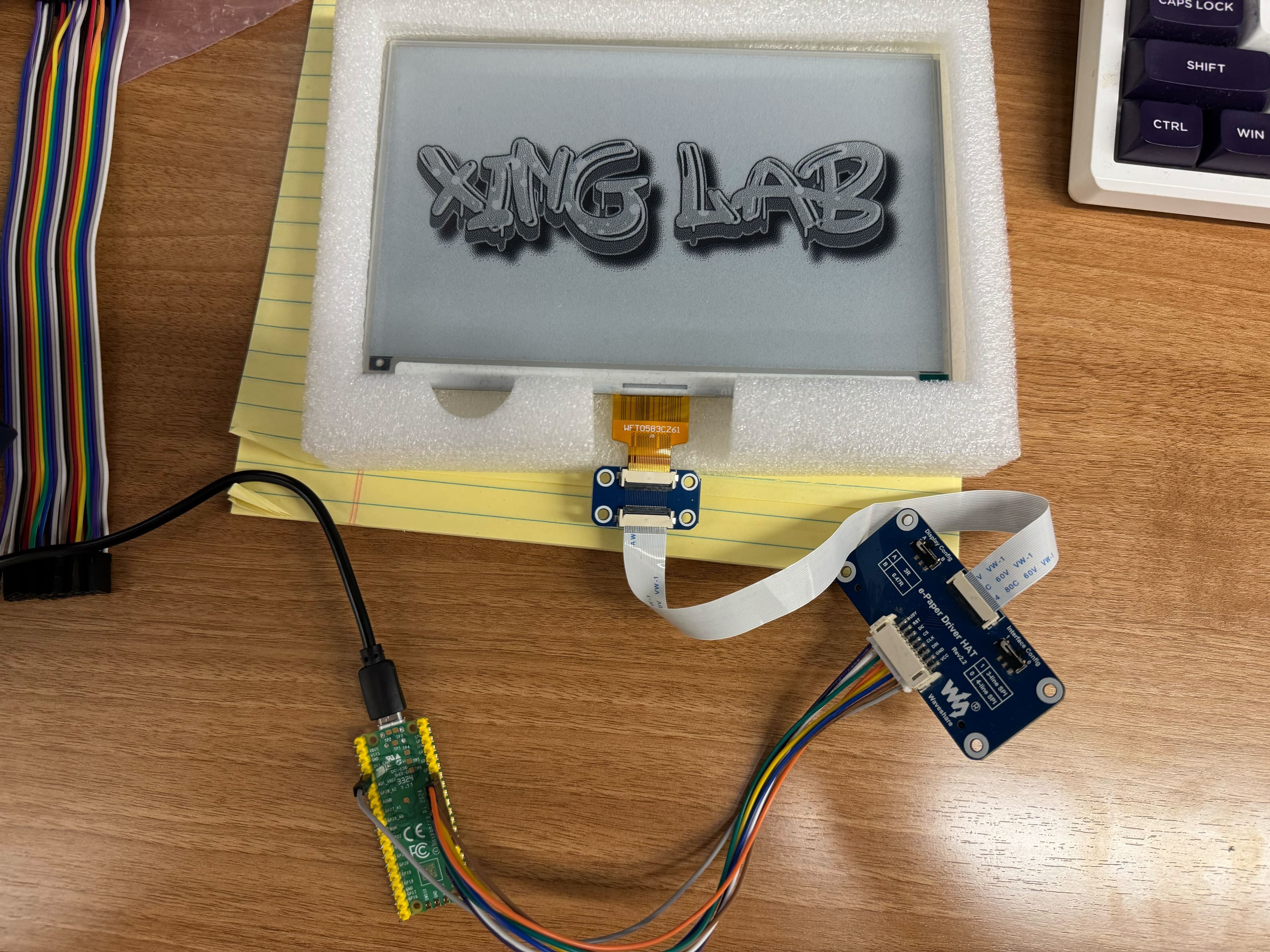Driving WaveShare E‐Paper Display with a Raspberry Pi Pico in MicroPython
E‐paper (a.k.a. “E‐Ink”) displays are perfect for low‐power and daylight‐readable applications. In this post, we’ll show how to wire up an 800 × 480 e‐paper display to a Raspberry Pi Pico, then walk through the MicroPython code to display images.
Hardware Setup
We’ll assume:
- A Waveshare‐style 7.5″ e‐paper module with SPI interface (resolution 800×480).
- A Raspberry Pi Pico 2 running MicroPython.
We need to use the SPI interface of the Pico. The Pico 2 has two SPI interfaces: SPI0 and SPI1. We’ll use SPI0. See the pinout below.

Pico 2 Pinout
Below are my pin connections. The e‐paper typically has the following signals:
| e‐Paper Pin | Description | Pico Pin for SPI0 Example |
|---|---|---|
| VCC | 3.3 V power | 3V3 (e.g. Pin 36) |
| GND | Ground | GND (e.g. Pin 38) |
| DIN | MOSI (SPI TX) | SPI0 TX / GP7 (Pin 10) |
| CLK | SCLK (SPI CLK) | SPI0 SCK / GP6 (Pin 9) |
| CS | SPI CS | SPI0 CSn / GP5 (Pin 7) |
| DC | Data/Command | GP8 (Pin 11) |
| RST | Reset | SPI0 RST / GP9 (Pin 12) |
| BUSY | Busy signal | GP10 (Pin 14) |
Note for GPIOs
For DC, RST, BUSY, you can actually use any GPIOs you want. I just randomly picked GP8, GP9, GP10. Of course, if you want to use other GPIOs, you need to change the code accordingly.
MicroPython Script on the Pico
Save the following script (e.g. epaper_800x480.py) to your Raspberry Pi Pico via Thonny or any other method. It defines a driver class, initializes the display, and can show an image.
import machine
import time
# -------------------------------------------------------------------------
# 1) Display resolution for 7.5" e-paper (800 x 480)
# -------------------------------------------------------------------------
EPD_WIDTH = 800
EPD_HEIGHT = 480
# -------------------------------------------------------------------------
# 2) Configure the Pico pins and SPI0
# -------------------------------------------------------------------------
# GP6 = SCK
# GP7 = MOSI
# GP4 = MISO (not used but must assign a pin)
# GP5 = CS
# GP8 = DC
# GP9 = RST
# GP10 = BUSY
spi = machine.SPI(
0,
baudrate=2_000_000,
polarity=0,
phase=0,
sck=machine.Pin(6),
mosi=machine.Pin(7),
miso=machine.Pin(4)
)
cs_pin = machine.Pin(5, machine.Pin.OUT, value=1)
dc_pin = machine.Pin(8, machine.Pin.OUT, value=0)
rst_pin = machine.Pin(9, machine.Pin.OUT, value=1)
busy_pin = machine.Pin(10, machine.Pin.IN)
def delay_ms(ms):
time.sleep_ms(ms)
def digital_write(pin, val):
pin.value(val)
def digital_read(pin):
return pin.value()
def spi_write_block(data_block):
spi.write(data_block)
# -------------------------------------------------------------------------
# 3) E‐Paper Driver Class
# -------------------------------------------------------------------------
class EPD_800x480:
def __init__(self):
self.width = EPD_WIDTH
self.height = EPD_HEIGHT
self.reset_pin = rst_pin
self.dc_pin = dc_pin
self.busy_pin = busy_pin
self.cs_pin = cs_pin
def hardware_reset(self):
digital_write(self.reset_pin, 1)
delay_ms(200)
digital_write(self.reset_pin, 0)
delay_ms(2)
digital_write(self.reset_pin, 1)
delay_ms(200)
def send_command(self, cmd):
digital_write(self.dc_pin, 0) # Command
digital_write(self.cs_pin, 0)
spi_write_block(bytes([cmd]))
digital_write(self.cs_pin, 1)
def send_data(self, data):
digital_write(self.dc_pin, 1) # Data
digital_write(self.cs_pin, 0)
spi_write_block(bytes([data]))
digital_write(self.cs_pin, 1)
def send_data_block(self, data_block):
digital_write(self.dc_pin, 1)
digital_write(self.cs_pin, 0)
spi_write_block(data_block)
digital_write(self.cs_pin, 1)
def read_busy(self):
while digital_read(self.busy_pin) == 0:
delay_ms(20)
def turn_on_display(self):
# Refresh
self.send_command(0x12)
delay_ms(100)
self.read_busy()
def init(self):
"""Initialize the display (power on, set registers, etc.).
Make sure to match your e‐paper’s datasheet or Waveshare example code!
"""
self.hardware_reset()
# Example sequence (replace with your display's official sequence):
# - POWER SETTING
# - PANEL SETTING
# - TRES (resolution)
# - etc.
# This is a placeholder; adapt to your hardware:
self.send_command(0x01) # POWER SETTING
self.send_data(0x07)
self.send_data(0x07)
self.send_data(0x3f)
self.send_data(0x3f)
self.send_command(0x04) # POWER ON
delay_ms(100)
self.read_busy()
self.send_command(0x00) # PANEL SETTING
self.send_data(0x1F)
# TRES: set resolution 800x480
self.send_command(0x61)
self.send_data(0x03) # 800 >> 8
self.send_data(0x20) # 800 & 0xFF
self.send_data(0x01) # 480 >> 8
self.send_data(0xE0) # 480 & 0xFF
self.send_command(0x15)
self.send_data(0x00)
self.send_command(0x50)
self.send_data(0x10)
self.send_data(0x07)
self.send_command(0x60)
self.send_data(0x22)
# -- CHUNKED SENDING to save memory --
def _send_zeros_in_chunks(self, total_size, chunk_size=512):
zero_chunk = b'\x00' * chunk_size
sent = 0
while sent < total_size:
remain = total_size - sent
if remain >= chunk_size:
self.send_data_block(zero_chunk)
sent += chunk_size
else:
self.send_data_block(b'\x00' * remain)
sent += remain
def _send_inverted_data_in_chunks(self, data, chunk_size=512):
idx = 0
length = len(data)
while idx < length:
end = min(idx + chunk_size, length)
slice_data = data[idx:end]
inverted = bytearray(len(slice_data))
for i, b in enumerate(slice_data):
inverted[i] = ~b & 0xFF
self.send_data_block(inverted)
idx = end
def display(self, black_buffer):
"""black_buffer is a bytes/bytearray of 48,000 bytes (800x480 // 8).
We'll invert each byte on the fly, because the hardware often
expects 1=white and 0=black.
"""
size = (self.width * self.height) // 8
# 1) Send old data (all white) in chunks
self.send_command(0x10)
self._send_zeros_in_chunks(size)
# 2) Send new data (inverted)
self.send_command(0x13)
self._send_inverted_data_in_chunks(black_buffer)
self.turn_on_display()
def clear(self):
"""Clear the screen to white."""
size = (self.width * self.height) // 8
self.send_command(0x10)
self._send_zeros_in_chunks(size)
self.send_command(0x13)
self._send_zeros_in_chunks(size)
self.turn_on_display()
def sleep(self):
"""Deep sleep / power off the display."""
self.send_command(0x02) # POWER OFF
self.read_busy()
self.send_command(0x07) # DEEP_SLEEP
self.send_data(0xA5)
delay_ms(2000)
# -------------------------------------------------------------------------
# EXAMPLE USAGE
# -------------------------------------------------------------------------
def main():
epd = EPD_800x480()
epd.init()
# Clear the screen
epd.clear()
# Suppose you uploaded an 800x480 BIN file to the Pico (flash),
# containing 48,000 bytes of 1-bit data:
with open("image_800x480.bin", "rb") as f:
image_data = f.read()
# Display it
epd.display(image_data)
# Wait a few seconds, then sleep
delay_ms(5000)
epd.sleep()
if __name__ == "__main__":
main()
Preparing the Image
You need a 1‐bit (black & white) image of 800×480 pixels. On your desktop (regular Python), you can use Pillow to convert any color image:
#!/usr/bin/env python3
import argparse
from PIL import Image
def main():
parser = argparse.ArgumentParser()
parser.add_argument("--input", "-i", required=True, help="Input image (png/jpg)")
parser.add_argument("--output", "-o", required=True, help="Output bin file")
args = parser.parse_args()
# 1) Open and resize/crop your image to 800x480 if needed
img = Image.open(args.input).convert("RGB")
img = img.resize((800, 480))
# 2) Convert to 1-bit
bw_img = img.convert("1") # uses dithering or pass dither=Image.NONE
pixels = bw_img.load()
width, height = bw_img.size
buf = bytearray(width*height//8)
idx = 0
for y in range(height):
for x_block in range(0, width, 8):
b = 0
for bitpos in range(8):
px_val = pixels[x_block+bitpos, y]
# px_val is 0 (black) or 255 (white) typically
if px_val >= 128:
# White => bit=1
b |= (1 << (7 - bitpos))
buf[idx] = b
idx += 1
with open(args.output, "wb") as f:
f.write(buf)
print(f"Saved {len(buf)} bytes to {args.output}")
if __name__ == "__main__":
main()
Run it like:
python image_to_bin.py --input myphoto.png --output image_800x480.bin
Copy image_800x480.bin to the Pico (for example, using Thonny’s View → Files).
Running on the Pico
- Open Thonny (or your favorite MicroPython IDE).
- Copy
epaper_800x480.pyon your desktop. - Copy
image_800x480.binonto the Pico as well. - Run
epaper_800x480.py. It should initialize the display, clear it, then show your converted image!
If everything works correctly, you’ll see your black‐and‐white image on the e‐paper.
Common Issues / Tips
- MemoryError: If you see
MemoryError: memory allocation failed, it usually means you tried to create a massive array. The chunked approach in the code above avoids that. - Inversion: If your display is reversed (white is black, black is white), see if you need to remove or alter the
~b & 0xFFlogic. - Partial Updates: Some e‐paper displays support partial refresh. You’d need a more advanced sequence for partial updates.
- Slowness: E‐paper refresh can take 2–3 seconds or more, especially in large displays. That’s normal.
Conclusion
That’s it! You’ve successfully driven a large 7.5″, 800×480 e‐paper from a Raspberry Pi Pico with MicroPython. The key is to send data in small chunks to save memory and invert bits on the fly if the hardware expects it.
E‐paper offers a gorgeous, low‐power way to show static images, signage, or dashboards. Now that you have the basics, you can expand to draw text, shapes, or partial updates.

E‐paper display
Happy hacking with e‐paper and Pico!
© LICENSED UNDER CC BY-NC-SA 4.0
